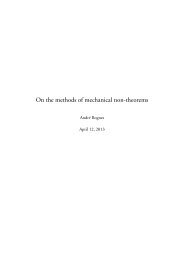The syntax of correlative adverbs
The syntax of correlative adverbs
The syntax of correlative adverbs
You also want an ePaper? Increase the reach of your titles
YUMPU automatically turns print PDFs into web optimized ePapers that Google loves.
438 J.B. Johannessen / Lingua 115 (2005) 419–443<br />
8. Previous analyses: Larson and Schwarz<br />
Both Larson (1985) and Schwarz (1999) focus on the analysis <strong>of</strong> the pair either-or.<br />
However, their analyses are very different. Larson’s (1985) analysis is based on movement.<br />
It suggests that whenever either occurs in a position other than adjacent to (just to the left<br />
<strong>of</strong>) the conjuncts, movement has taken place:<br />
(74) John either i ate t i [ NP rice] or [ NP beans]<br />
(75) Either i John ate t i [ NP rice] or [ NP beans]<br />
Schwarz’s (1999) analysis is based on reduction (i.e. deletion): whenever the word either<br />
occurs, it is situated exactly next to the conjuncts. Thus, the conjuncts in, for example, (76)<br />
are not in fact rice and beans, but VPs where the verb is deleted in the second conjunct.<br />
Similarly, the conjuncts in (77) are IPs the second <strong>of</strong> which has undergone deletion.<br />
Both these approaches are too simple to account for the crucial data from Germanic<br />
languages. Both Schwarz’s reduction analysis and Larson’s movement analysis take it for<br />
granted that certain conditions are met. To put it briefly: for both analyses, it is necessary<br />
for the <strong>correlative</strong> to be in a position that is to the left <strong>of</strong> its conjunction phrase (ConjP), as<br />
in (74)–(77), i.e. with a structure like this:<br />
(78) ... Correlative ... [ ConjP Conjunct Conjunction Conjunct]<br />
However, it is not always the case that the <strong>correlative</strong> occurs in just these configurations.<br />
We have seen that even in English, there are examples <strong>of</strong> sentences where the <strong>correlative</strong> is<br />
inside the first conjunct, cf. Larson’s own example (repeated from above):<br />
(79) [ ConjP [Mary either is driving to the airport] or [she is taking a cab]].<br />
(Larson, 1985: 235)<br />
<strong>The</strong> structure <strong>of</strong> the sentence, which seems to be IP coordination with a <strong>correlative</strong> in the<br />
first conjunct, would be:<br />
(80) [ ConjP [ IP ... Correlative ... ] Conj [ IP ... ]]<br />
This makes both Larson’s movement and Schwarz’s deletion analysis much less straightforward<br />
(see also Hendriks, 2001b: 3 on this point). Thus, if the <strong>correlative</strong> is inside a<br />
conjunct, it cannot be the case that the whole conjunction phrase is on its right-hand side (as<br />
Schwarz claims). Neither can it be the case that the <strong>correlative</strong> has started out on the lefthand<br />
side <strong>of</strong> the conjunction phrase (ConjP) and then moved (as Larson claims), since that
















